Classic Anabaptist and Mennonite History Collection (19 vols.)
Digital Logos Edition
Overview
While most Christians are familiar with the events and major participants of the Reformation, many still don’t know very much about the Anabaptists—a sect of breakaway Christians who rejected the Roman Catholic Church and the idea of state churches altogether. Holding to principles of nonviolence, renunciation of the oath (based principally on Matthew 5:34–37 and James 5:12), and believer’s baptism, the Anabaptists were persecuted for their beliefs by Catholics and Protestants. Among the various leaders of this pious group, Menno Simons became so influential that other Anabaptist leaders started referring to his Dutch followers as Mennonites.
Over the course of time, historians have pored over the writings of this much maligned and misrepresented group of Christians. The Classic Anabaptist and Mennonite History Collection (19 vols.) brings together some of the best classical scholarship on their history and theology. It contains several works on the origins of Anabaptism, scholarly accounts of the Münster Rebellion, biographical accounts of important Anabaptist leaders and martyrs, several works detailing their unique contribution to American history as early pioneers, and much more. The Classic Anabaptist and Mennonite History Collection (19 vols.) is indispensible for understanding the roots of Anabaptist history and doctrine.
Containing the writings of early Anabaptists like Menno Simons and Balthasar Hübmaier, as well as works from twentieth-century Mennonite scholars like Daniel Kauffman and J. S. Hartzler, the Classic Anabaptist and Mennonite History Collection (19 vols.) is a must-have for those interested in Reformation history. With the Logos edition, all Scripture passages in the Classic Anabaptist and Mennonite History Collection (19 vols.) are tagged and appear on mouse-over. What’s more, Scripture references are linked to the wealth of language resources in your Logos library, making these texts more powerful an
d easier to access than ever before for scholarly work or personal Bible study. With the advanced search features of Logos Bible Software, you can perform powerful searches by topic or Scripture reference—finding, for example, every mention of "jus gladii" or "Matthew 5:3."

- The Complete Works of Menno Simons included
- Works on Anabaptist history and theology
- Biographical works on some of the most important Anabaptist leaders
- Commentary on Revelation 20 from Peter Jan Twisk
- Histories of the Mennonites in the United States of America
- Title: Classic Anabaptist History Collection (19 vols.)
- Volumes: 19
- Pages: 5,666
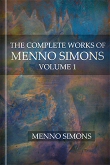
First ordained as a Roman Catholic priest, Menno Simons later rejected the Catholic Church and joined with the Anabaptists in 1536. For the next 25 years, Menno’s writings and sermons on adult baptism, piety, and nonviolence would become so influential, other leaders began referring to the Dutch Anabaptists as Mennonites. Volume one of The Complete Works of Menno Simons contains the following:
- Conversion of Menno Simons, and His Renunciation of the Church of Rome
- A Foundation and Plain Instruction of the Saving Doctrine of Our Lord Jesus Christ
- The True Christian Faith, Which Converts, Changes, Makes Pious, Sincere, New, Peaceful, Joyful, and Blessed the Human Heart
- A Fundamental Doctrine from the Word of God
- A Consoling Admonition Concerning the Sufferings, Oppressions, and Persecutions of the Saints
- A Pleasing Meditation and Devout Contemplation on the Twenty-Fifth Psalm
- A Plain Instruction from the Word of God, Concerning the Spiritual Resurrection, and New or Heavenly Birth
- A Fundamental Doctrine, or An Account of Excommunication, Ban, Exclusion or Separation from the Church of Christ
- A Pleasing Instruction and Doctrine How All Pious Parents, According to the Scriptures, are Required to Govern, Correct, and Educate Their Children
- Letters Written by Menno Simons
Menno Simons (1496–1561) was a Dutch Anabaptist leader from Friesland whose followers became known as the Mennonites. Simons was ordained into the Roman Catholic Church in 1516—even though he had yet to read the Bible. When Simons began questioning his beliefs, he began to study the Bible in earnest, as well as the writings of the Early Church Fathers. He was also influenced by the writings of Martin Luther and Heinrich Bullinger. In 1536, Simons officially rejected the Catholic Church and fell in with a group of Anabaptists after he moved to Witmarsum. A turbulent time in Anabaptist history, Simons rejected the radical strain of Anabaptists, and instead expressed a theology based on peace, piety, and adult baptism. An influential leader and writer, Simons’ followers became known as Mennonites.
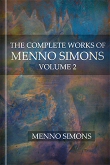
First ordained as a Roman Catholic priest, Menno Simons later rejected the Catholic Church and joined with the Anabaptists in 1536. For the next 25 years, Menno’s writings and sermons on adult baptism, piety, and nonviolence would become so influential, other leaders began referring to the Dutch Anabaptists as Mennonites. Volume 2 of The Complete Works of Menno Simons contains the following:
- A Reply to a Publication of Gellius Faber
- A Very Humble Supplication of the Poor, Despised Christians
- A Brief Complaint or Apology of the Despised Christians and Exiled Christians
- A Treatise on, and Scriptural Explanation of Excommunication
- A Clear, Incontrovertible Confession and Demonstration, Founded on the Power of the Holy Scriptures—A Reply to John A’lasco
- A Confession of the Triune, Eternal and True God, Father, Son, and Holy Ghost
- An Explanation of Christian Baptism in the Water from the Word of God
- The Reason Menno Simons Does Not Cease Teaching and Writing
- A Fundamental and Clear Confession of the Poor and Distressed Christians
- A Thorough Answer to the Slander, Defamation, Backbiting, Unseasoned and Bitter Words of Zylis and Lemmekes Concerning the Ban, Separation, or Shunning
- A Humble and Christian Justification and Replication
- A Brief and Clear Confession and Scriptural Demonstration
- A Very Plain and Pointed Reply to the Anti-Christian Doctrine
- A Very Sincere Epistle to Martin Micron
- A Plain and Convincing Proof, from the Scriptures, That Jesus Christ Is the True, Promised, Spiritual David, the King of Kings, the Lord of Lords
- A Kind Admonition or Instruction from the Word of God, How a Christian Should Be Disposed
Menno Simons (1496–1561) was a Dutch Anabaptist leader from Friesland whose followers became known as the Mennonites. Simons was ordained into the Roman Catholic Church in 1516—even though he had yet to read the Bible. When Simons began questioning his beliefs, he began to study the Bible in earnest, as well as the writings of the Early Church Fathers. He was also influenced by the writings of Martin Luther and Heinrich Bullinger. In 1536, Simons officially rejected the Catholic Church and fell in with a group of Anabaptists after he moved to Witmarsum. A turbulent time in Anabaptist history, Simons rejected the radical strain of Anabaptists, and instead expressed a theology based on peace, piety, and adult baptism. An influential leader and writer, Simons’ followers became known as Mennonites.
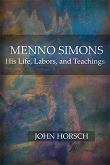
John Horsch’s biography of Menno Simons provides an important history of the Anabaptists and early Mennonites, focusing on Menno Simons’ life and works. Menno Simons: His Life, Labors, and Teachings is full of biographical information about many of Simons’ contemporaries and gives a unique perspective of the Reformation. Horsch also provides an Anabaptist dictionary of key people, places, and doctrines as well as an abbreviated time-line of Menno Simons’ various points of doctrine and practice. Contents include:
- Menno Simons’ Conversion and Baptism
- Menno Simons’ Call to the Ministry and Ordination
- The Anabaptists
- Menno Simons’ Motives, Aims, and Endeavors
- Menno’s Labors in the Netherlands
- The Difficulties under Which Menno Simons Labored
- Menno’s Flight to Germany and Labors in the Electorate of Cologne
- From the Flight from Cologne to the Discussions at Wismar
- Menno Simons’ Relation to the State-Church Reformation
- Menno’s Attitude toward Rationalism
- Menno on Church Discipline
- Menno Simons’ Doctrine on the Incarnation of Christ
- Menno Simons’ Attitude toward the Munsterites
- The Batenburgers and the Davidites
- Adam Pastor
- Recent Accusations against Menno Simons
- A Letter of Menno Simons to a Timid Believer
- Menno in Wustenfelde. His Death. His Place in the History of the Reformation
- Menno Simons on Various Points of Doctrine and Practice
- Menno’s Writings
It is of value to have in English a really authoritative life of the great Dutch radical of the Reformation. We are so accustomed to hear only of Luther, Zwingli, and Calvin, that we frequently forget that there was a large part of the Reformation movement bitterly hostile to the so-called ‘orthodox’ reformers. For Menno Simons and his many followers, Luther and his confreres were hardly better than the Pope with his Cardinals.
—Anglican Theological Review
The Historical value of the book is very considerable, the author’s diligence is exemplary, and a quantity of material has been brought together from various sources that has never before been printed in English.
—The American Historical Review
John Horsch (1867–1941) was born in Germany and immigrated to America in 1887. After learning English from the Indian Mission School under Christian Krehbiel, he began to work as an editor for the Mennonite Publishing Company. Aside a few intermittent years of further study, Horsch worked as an editor, researcher, and writer for the Mennonite Publishing Company for over 50 years. He authored numerous works, including Infant Baptism: Its Origin Among Protestants, The Principle of Nonresistance as Held by the Mennonite Church, and The Hutterian Brethren: A Story of Martyrdom and Loyalty. He has the credit of discovering the modern Hutterites and their historical manuscripts and introducing them to modern scholarship.
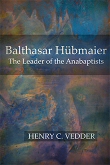
A popular pulpiter in his day, Balthasar Hübmaier is an important figure of the Reformation that has been largely forgotten. Henry C. Vedder provides a history of Balthasar Hübmaier and analyzes his works. An extensive bibliography and over 20 illustrations are included. Contents include:
- The Anabaptists and the Reformation
- The Years of Preparation
- Hübmaier an Evangelical Reformer
- Hübmaier Becomes an Anabaptist
- Hübmaier at Nikolsburg
- The Teachings of Hübmaier
- Hübmaier the Martyr
- The Suppression of the Moravian Anabaptists
- “On the Sword”
Praise for the Print Edition
Professor Vedder has written an interesting biography of Hübmaier, and given a scholarly account of this reformer’s writings.
—Review of Theology and Philosophy
These ’Anabaptists’ were the advance-guard of the Reformation—those in which the formative principles of evangelical religion found their purest expression; and their leaders were at least the peers of those whose names have come down to us clothed with more glory merely because the accidents of the time gave them more success. A carefully written and instructive volume.
—The Princeton Theological Review
The illustrations are well executed, and the biography is written with judgment and good taste.
—New York Observer
One needs to make a special study of this much-despised and slandered sect to form any conception of the importance of their influence, the heroism and, in many cases, sanctliness of their lives, and the atrocity of the treatment they received at the hands of the Catholics and Protestants. The volume is an exhaustive treatment of its subject, and an important contribution to history.
—The Christian Work and the Evangelist
Henry C. Vedder (1853–1935) was educated at the University of Rochester and Rochester Theological Seminary and was a professor of church history at Crozer Theological Seminary. Vedder also served as an editor for The Examiner, Baptist Quarterly Review, and the Chester Times. His numerous works include A Short History of the Baptists, Christian Epoch Makers, Socialism and the Ethics of Jesus, and The Gospel of Jesus and the Problems of Democracy.
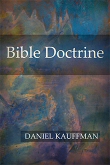
At the Mennonite General Conference of 1911, a committee of 10 was appointed to prepare a work on Christian doctrine. The design of the work was not to serve as a confession of faith, but rather as an exposition of the doctrines which a confession of faith ought to contain. A table of contents was formed and writers were chosen to prepare each chapter. They divided the contents into 8 distinct sections:
- God and Man
- Satan and His Works
- The Plan of Salvation
- The Church
- Christian Ordinances
- Christian Principles
- Christian Graces
- Future Destiny of Man
Daniel Kauffman (1865–1944) earned a degree of Principal of Pedagogics from Missouri State University and was ordained in the Mennonite Church in 1892, then made a bishop in 1896. He served as an editor for the Gospel Witness and the Gospel Herald, and helped launch Beams of Light and the The Sunday-School Teacher’s Quarterly. Kauffman was a prolific author whose works include Manual of Bible Doctrine, One Hundred Lessons in Bible Study, The Conservative Viewpoint, and The Gospel Mirror.
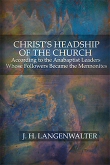
The movement, known as Anabaptism, affords a rich field for speculation because of the fact that it came into such prominence during the Reformation period; because so many divisions, sects, and denominations either grew out of it or came through it; and because of the nature of the sources upon which we are dependent for our information. Culling a mass of historical material, Langenwalter maintains that only through the lives and writings of its early leaders can a true understanding of Anabaptism be formed. Chapters include:
- A Survey of the Times and Conditions in Which the Mennonite Church Was Born
- Characteristics of Anabaptists
- Representative Leaders of the Anabaptists and Early Mennonites
- Ways in Which the Conceptions of These Leaders Regarding Christ’s Headship of the Church Found Expression
Jacob Hermann Langenwalter (1877–1965) was educated at Bethel College, Baldwin Wallace College, Oberlin Theological Seminary, Harvard University, Hartford Theological Seminary, and was awarded an honorary degree of DD from Baldwin Wallace. He taught at numerous colleges and served as president of Bethel College for four years. His works include For All Mankind, The Challenge of the Present: Three Lectures, and The Charge of the Church of Jesus Christ to You.
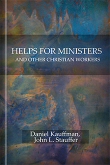
This guidebook on and for the ministry is helpful to new and experienced ministers of the Word. Defining the mission of Church leaders, providing a list of helpful texts in different areas of concern, and providing sample sermon outlines are just a few of the helpful areas covered in Helps for Ministers and Other Christian Workers. Chapters include:
- The Minister of the Gospel
- The Preacher’s Equipment
- The Pastor and His Congregation
- The Gospel Message
- Biblical Instructions for God’s Messengers
- Some Common Errors to Be Avoided
- Ministerial Problems
- Biblical Illustrations
- Anecdotes and Illustrations
- Anecdotes and Illustrations (Continued)
- Different Styles of Sermons
- Sermon Outlines
- Sermon Outlines (Continued)
- A Symposium of Texts
- Visitation Work
- “Be Strong in the Lord”
- Public Worship
- Of Interest to Ministers and Other Workers
Praise for the Print Edition
Helps for Ministers and Other Christian Workers informed me how to organize a filing system and accumulate clippings on a wide range of topics.
—John A. Hostetler, best-selling author of Amish Life and Amish Society
Daniel Kauffman (1865–1944) earned a degree of Principal of Pedagogics from Missouri State University and was ordained in the Mennonite Church in 1892, then made a bishop in 1896. He served as editor for the Gospel Witness and Gospel Herald, and helped launch Beams of Light and The Sunday-School Teacher’s Quarterly. Kauffman was a prolific author whose works include Manual of Bible Doctrine, One Hundred Lessons in Bible Study, The Conservative Viewpoint, and The Gospel Mirror.
John L. Stauffer (1888–1959) was ordained a minister in 1911 and taught at Eastern Mennonite College in Harrisonburg, VA. Stauffer also moderated the Mennonite Church General Conference from 1947–1949. He published numerous articles and tracts and was a frequent guest speaker at Bible conferences.
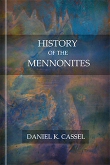
History of the Mennonites contains brief sketches of the Mennonites in America, beginning with the first settlement and organization at Germantown, PA. From there, Cassel documents the settlements in Virginia, West Virginia, Missouri, Indiana, Nebraska, and more. History of the Mennonites is packed with historical documents, biographical information on some of the more prominent ministers, and dozens of illustrations.
Mr. Daniel K. Cassel has contributed in his History of the Mennonites a valuable addition to our somewhat slender stock of knowledge of this sort concerning the earliest settlers of Pennsylvania, still represented here by churches and congregations and including among their members many well-known citizens.
—The American: A National Journal
Daniel K. Cassel (1820–1898) taught in local schools in Montgomery County, Pennsylvania for over 20 years. He retired with his wife in Germantown and wrote numerous works, including Eine schoene Sammlung auserlesener Gebete und Lieder zum Gebrauch der Jugend, Katechismus oder kurze und einfältige Unterweisung nebst den Zehn Geboten, and Geschichte der Mennoniten.
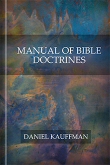
Manual of Bible Doctrines was written for those new to the Christian faith, particularly those interested in the Mennonite faith. Arranged by topic, Kauffman walks the reader through the most important doctrines of the faith, including conversion, justification, sin, repentance, baptism, and more. Chapters include:
- The Creation
- The Fall of Man
- Sin
- Faith
- Repentance
- Conversion
- Regeneration
- Justification
- The Redemption of Man
- The Ministry
- The Members
- Baptism
- The Communion
- Feet-Washing
- Woman’s Prayer Head-Covering
- The Salutation of the Holy Kiss
- Anointing with Oil
- Marriage
- Non-Conformity to the World
- Non-Resistance
- Swearing of Oaths
- Going to Law
- Secret Societies
- Sanctification
- Prayer
Daniel Kauffman (1865–1944) earned a degree of Principal of Pedagogics from Missouri State University and was ordained in the Mennonite Church in 1892, then made a bishop in 1896. He served as editor for the Gospel Witness and the Gospel Herald, and helped launch Beams of Light and the The Sunday-School Teacher’s Quarterly. Kauffman was a prolific author whose works include Manual of Bible Doctrine, One Hundred Lessons in Bible Study, The Conservative Viewpoint, and The Gospel Mirror.
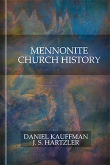
Hartzler and Kauffman provide an in-depth history of the Mennonite Church. Tracing their roots to the Church of the first century, the authors then outline the various precursors to Menno Simons teachings—the Novatians, Catharists, Paulicians, Henricans, Albigenses, Waldenses, and the Anabaptists. Kauffman and Hartzler then move to the European Mennonites and the new European settlements in America. Packed with interesting historical documents, such as the “Mennonite Confession of Faith” and letters dating from the seventeenth century from Mennonite leaders protesting slavery, this volume is indispensible for understanding the roots of Mennonite history and doctrine.
Daniel Kauffman (1865–1944) earned a degree of Principal of Pedagogics from Missouri State University and was ordained in the Mennonite Church in 1892, then made a bishop in 1896. He served as editor for the Gospel Witness and Gospel Herald, and helped launch Beams of Light and The Sunday-School Teacher’s Quarterly. Kauffman was a prolific author whose works include Manual of Bible Doctrine, One Hundred Lessons in Bible Study, The Conservative Viewpoint, and The Gospel Mirror.
Jonas Smucker Hartzler (1857–1953) was educated at Wooster College and was an instructor in Bible at the Elkhart Institute. He later taught at Goshen College and served as Secretary of the Mennonite General Conference for over twenty years. For many years he was the editor of Rural Evangel and the author of Among Missions in the Orient and Observations by the Way and Mennonites in the World War or Nonresistance under Test.
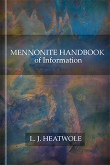
This handbook serves as a quick reference guide for brief accounts of events that happened along the historical thread of more than 200 years relating to the development of the Mennonite church in the United States of America. Contents include:
- “Who Are the Mennonites?”
- Life and Labors of Menno Simons
- Mennonite Confession of Faith
- Mennonite General Conference and District Conferences
- General Church Activities
- How Mennonites Are Confronting the Menace of Modernism
- A Sketch of Very Early Mennonite History
- The Plockhoy Colony in Delaware
- Germantown the First Permanent Mennonite Colony
- The Story of Rudolph Cronau
- Sidelights to Mennonite History
- Persistent Colonization Movements
- Losses Sustained by the Parent Church
- Other Mennonite Bodies
- The Kingdom of Peace and the Kingdom of Force
- Overtures of Indians Were First Peaceful, Then Revengeful
- Trials of Mennonites During the Revolutionary War
- The War of 1812 and the Mexican War
- Mennonites During the Civil War
- Testing Times During the Great World War
- Historical Outline of Mennonite Literature
- How Mennonites Lived in Former Generations
- Efforts for Establishing a Reconciliation
- Plans for Establishing a General Conference for Unity
- List of American Mennonite Books and Periodicals
- Administrative and Benevolent Institutions of the Church
- Summary of Deaths, with Some Tragic Events in Mennonite History
- Biographical Sketches of Prominent Mennonite Leaders
Lewis James Heatwole (1852–1932) was ordained a minister in 1887, then a bishop in 1892. Besides his ministerial duties, Heatwole was also an astronomer, teacher, a calculator of almanacs, and an official observer for the US Weather Bureau. His numerous works include Baptism Shown to Be a Ceremony of Consecration, Key to the Almanac and the Sidereal Heavens, Moral Teaching in the Public Schools: A Treatise Designed for Teachers, and The Perpetual Calendar.

As one who was actively engaged in looking after the welfare of young male Mennonites, who for conscience sake, could take no part in the First World War, J. S. Hartzler was selected by the Mennonite General Conference to undertake a careful writing of the events, to make a clear statement of issues involved, and to create a record of what nonresistant people did to meet the problems arising from the war. In the introduction provided by Albert J. Steiner, he writes: “The principles of peace and opposition to war have been deeply implanted into the very lifeblood of every true Mennonite through four centuries, and to violate this now would rob them of a sacred religious principle, giving them a guilty conscience before God.” This volume provides an important history of the Mennonite church during one of the most trying times in American history. Chapters include:
- Early History of the Church
- Mennonites and Other Wars
- The World War
- The Issues Involved
- Important Meetings and Their Results
- Our Brethren in Canada
- Our Brethren in the Draft
- Our Brethren in the Draft (Continued)
- Our Brethren in the Draft (Continued)
- Some Experience in Camp
- The Disciplinary Barracks
- Home Experience Which Grew Out of War Measures
- Camp Visitations
- Relief Work
- Lessons Taught By the War
- Problems for the Church
This carefully written book has not a little quiet reserve and plain straight-forwardness.
—The Friend
Jonas Smucker Hartzler (1857–1953) was educated at Wooster College and was an instructor in Bible at the Elkhart Institute. He later taught at Goshen College and served as secretary of the Mennonite General Conference for over 20 years. For many years he was the editor of Rural Evangel and the author of Among Missions in the Orient and Observations by the Way.
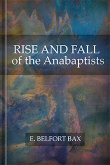
This scholarly review of German Anabaptists during the Reformation details the split in the Anabaptist community during the Münster Rebellion of 1534–1535. Interpreting this episode is where Bax contends previous historians are at fault in their blanket assessment of Anabaptism and its historical leaders. Chapters include:
- Beginnings of Anabaptism
- The Anabaptist Doctrines and Practice
- Persecution of the Anabaptists and Death of the Earlier Leaders
- Melchor Hoffman and the Revolutionary Movement
- The Reformation Movement in the Episcopal Territories of Münster
- The Reign of the Saints
- The New Israel
- The Propaganda Outside Münster
- Münster’s Fall and the Fate of the Movement
- The Anabaptist Movement in England
The story is a most instructive one and admirably told by Mr. Belfort Bax; it has threefold interest, historical, religious, and social.
—The Westminster Review
Mr. Bax is just the man to write the history of Anabaptism. He is a historian, careful to seek and cautious to use the first-hand sources for his history; he has made himself acquainted with this very period as few others have done; and above all, he is in sympathy with his subject. He understands the men, he understands the movement, as very few historians have done or tried to do.
—The Expository Times
Ernest Belfort Bax (1854–1926) was a British socialist journalist and philosopher. A prolific writer, his works include Handbook to the History of Philosophy, Religion of Socialism, and German Culture Past and Present.
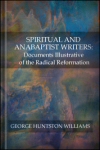
This volume comprises of a group of sixteenth-century writings once cherished and influential in fairly wide circles and intrinsically of no slight importance, but little known to modern readers. This anthology of Anabaptist writings includes sermons, addresses, letters, essays, and more, and editor George Williams supplies notes and annotations on all of them. Authors include:
- George Blaurock
- Thomas Müntzer
- Conrad Grebel
- John Denck
- Balthasar Hubamaier
- Michael Sattler
- Sebastian Franck
- Caspar Schwenckfeld
- Melchior Hofmann
- Obbe Philips
- Dietrich Philips
- Menno Simons
- and more
George Huntston Williams (1914–2000) was educated at St. Lawrence University, Meadville Theological School, and Union Theological Seminary, where he received his PhD. He then taught at Harvard Divinity School. He was also among the original Editorial Advisors of the scholarly journal Dionysius. His works include The Polish Brethren and The Attitude of Liberals in New England toward Non-Christian Religions, 1784–1885.
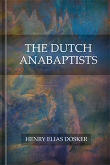
Henry Elias Dosker delivered the Stone Lectures at Princeton Theological Seminary in 1918, and The Dutch Anabaptists includes the original content of those lectures, revised and expanded. Dosker traces the history and development of the Anabaptists, gives biographical accounts of their leaders, and outlines their theology. Lectures include:
- Origin and Early Development
- The Radical Anabaptists
- The Conservatives
- The Theology of the Dutch Anabaptists
- Internal Conditions and Views of Life
- Later History
The book will be a surprise to those who know the Anabaptists only as a name. In purity of life, peaceableness, and willingness to suffer martyrdom even for their faith they remind one of those early disciples whose white lives shamed their persecutors and finally overcame evil with good.
—Missions: An International Baptist Magazine
Henry Elias Dosker was professor of Church history at the Presbyterian Seminary in Louisville, Kentucky. His works include Outline Studies in Church History, John of Barneveldt: Martyr or Traitor?, and Topical Outline Studies in Ecclesiastical History.
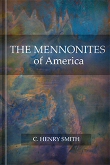
Beginning with the Anabaptists and the Mennonites of Europe, C. Henry Smith traces the history of the Mennonite church and its founding of Mennonite colonies in America. Having founded the first German colony in America and being among the pioneers in many of the frontier settlements in the westward expansion of the American people, the American Mennonite story proves to be an important part of American history. Chapters include:
- The Anabaptists
- Menno Simons and the Mennonites of Europe
- Cornelisz Pieter Plockhoy and the Mennonite Colony on the Delaware
- Germantown
- The Pequea Colony
- Franconia
- Expansion of the Pequea Colony Before 1800
- The Amish
- During the Revolution
- The Mennonites of Ontario
- The Mennonites During the Nineteenth Century
- The Immigration from Russia
- The General Conference of Mennonites
- The Mennonites and the State
- Principles, Customs, and Culture
- Literature and Hymnology
- The Present
The 18 chapters of the book cover every phase of the church’s history, and show that the author has done a great amount of research work.
—The Indiana Quarterly Magazine of History
C. Henry Smith (1875–1948) was educated at Illinois State Normal University, University of Illinois, and the University of Chicago, where he received his PhD. A life-long Mennonite historian, his works include The Story of the Mennonites, The Coming of the Russian Mennonites: An Episode in the Settling of the Last Frontier 1874–1884, and Menno Simons: Apostle of the Nonresistant Life.
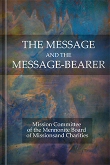
This handbook for Mennonite missionaries illuminates the core principles of the faith and the spirit of the message-bearers “devoted to the great cause of carrying the Gospel of Christ into all the world.” Chapters include:
- The Message
- The Creation
- Man
- The Bible
- The Church
- The Plan of Salvation
- Christian Ordinances
- Bible Restrictions
- The Blessed Hope
- The Message-Bearer
- The Call
- Qualifications (Natural)
- Qualifications (Spiritual)
- The Holy Life
- Helps and Hindrances
- Concluding Thoughts for Missionaries
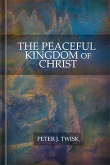
The Peaceful Kingdom of Christ is early Anabaptist writer Peter Jan Twisk’s commentary on the twentieth chapter of the book of Revelations. Written around 1600 AD, this valuable commentary was first translated from the Dutch into German in 1875 before this English edition was translated in 1913.
Peter J. Twisk was a bishop in the early Mennonite church.
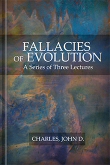
Fallacies of Evolution: A Series of Three Lectures
- Author: John D. Charles
- Publisher: Mennonite Publishing House
- Publication Date: 1917
- Pages: 48
This short pamphlet contains 3 lectures given to the student body of Hesston Academy and Bible School in 1916. Its mission is to establish and confirm the student in the faith of the truth of the Bible along the line that it is most frequently attacked by scholars and ripened intellectuality, and at the same time give correct information on questions of science relative to life and its development.
John Denlinger Charles (1878–1923) was educated at Franklin and Marshall College and Columbia University where he earned his MA in 1914. He served as secretary on the committee for revision of Bible Doctrine and was the author of Present Day Religions, also published by the Mennonite Publishing House.
Reviews
9 ratings

Gregory Sterner
11/15/2022
sirndrdlyf
12/20/2017

Victor Robidas
6/27/2014
Leland R Nisly
4/19/2014

Larry Proffitt (I
11/13/2013

Bill Shewmaker
10/8/2013

Robert J Smith
9/22/2013

RevSarge
8/5/2013

Doug
7/27/2013